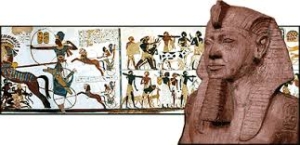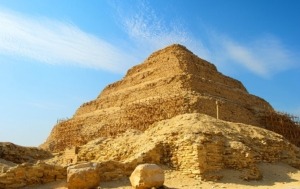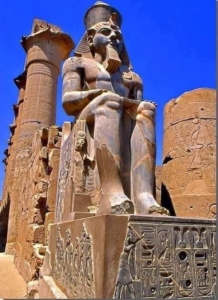In ancient Egypt, the pharaohs possessed a wealth of riches that were unparalleled in their time. These treasures were not just gold and jewels, but also artifacts that held deep cultural and historical significance. Among the most prized possessions were intricate sarcophagi, designed to protect the pharaohs on their journey to the afterlife.
The treasures of the Pharaohs of ancient Egypt are among the most remarkable and valuable artifacts in the world, reflecting the wealth, power, and sophistication of one of history’s greatest civilizations. Here are some of the most renowned treasures associated with the Pharaohs:
1. Tutankhamun’s Tomb
Discovered in 1922 by Howard Carter, the tomb of Pharaoh Tutankhamun (KV62) in the Valley of the Kings is perhaps the most famous archaeological find. Key treasures from this tomb include:
– The Golden Mask: Tutankhamun’s funerary mask, made of gold and inlaid with semi-precious stones, is an iconic symbol of ancient Egypt with weight of 11 kg from gold and precious stones
– Golden coffin : Amazing coffin with weight of 110 kg from pure gold .
– Golden Throne: A beautifully crafted throne adorned with scenes of the young pharaoh and his queen.
– Chariots: Ornate chariots that were likely used in ceremonies rather than battle.
– Canopic Shrine: A shrine containing canopic jars that held the pharaoh’s internal organs.
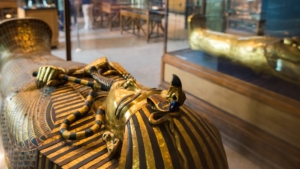
2. The Great Pyramids and the Sphinx
While not “treasures” in the traditional sense, the monumental architecture of the Great Pyramids of Giza and the Great Sphinx are invaluable cultural and historical treasures. Built during the Fourth Dynasty, these structures were created to house the remains of pharaohs like Khufu (Cheops), Khafre, and Menkaure.
– Pyramid Texts: The oldest religious texts in the world, found inside Unas pyramids, are inscribed to help the pharaohs in their journey to the afterlife.
3. The Treasure of Tanis
Discovered in the royal tombs at Tanis, the treasures of pharaohs such as Psusennes I offer impressive examples of craftsmanship. Highlights include:
– Golden Mask of Psusennes I: Similar in style to Tutankhamun’s mask but with its own distinctive features.
– Jewelry and Ornaments: Intricate pieces made from gold, silver, and precious stones.
– Silver coffin : An stunning design coffin made out from silver which was more preciouse than gold in ancient Egypt.
4. The Mummy of Ramses II
Ramses II, also known as Ramses the Great, was one of Egypt’s most powerful and celebrated pharaohs. Although his tomb had been plundered, his mummy, discovered in the Deir el-Bahri cache, is a significant find.
– Mummy Cases: The nested coffins and elaborate sarcophagi that contained his mummy.
5. The Valley of the Kings
This royal burial ground contains numerous tombs filled with treasures, although many were looted in antiquity. Notable tombs include:
– KV5: The tomb of the sons of Ramses II, the largest tomb in the Valley of the Kings.
– Tomb of Seti I: One of the most beautifully decorated tombs, known for its detailed and well-preserved wall paintings and carvings.
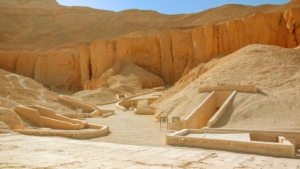
6. Queen Hetepheres’ Treasures
The mother of Khufu, Queen Hetepheres I, had a tomb filled with luxurious items, even though it was robbed in antiquity. Her remaining treasures included:
-Furniture: Exquisitely crafted pieces like her bed and chair.
-Jewelry: Gold and semi-precious stone jewelry.
7. The Rosetta Stone
While not a treasure from a tomb, the Rosetta Stone is an invaluable artifact that enabled the decipherment of Egyptian hieroglyphs. Discovered in 1799, it features inscriptions in three scripts: Greek, Demotic, and Hieroglyphic.
8. The Cairo Museum’s Collection
The Egyptian Museum in Cairo houses an extensive collection of treasures from various periods of ancient Egyptian history, including:
– The Narmer Palette: An important ceremonial engraving considered a key artifact in understanding the unification of Upper and Lower Egypt.
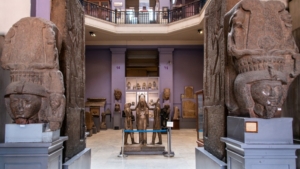
These treasures are not just valuable for their material worth but also for the cultural, historical, and scientific insights they provide into ancient Egyptian civilization.
If you willing one day to see these valubale treasure and visit Egypt , check this link here for more details and special organized tour packages to Egypt.
Written by ATW July 2024

